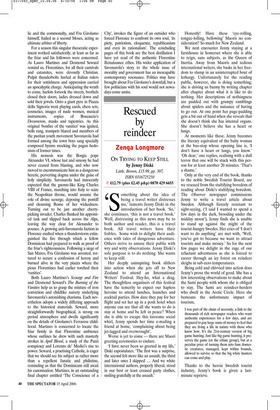Zero tolerance in Florence
Jonathan Keates
SCOURGE AND FIRE by Lauro Martines Cape, £20, pp. 336, ISBN 0224072528 ✆ £16 (plus £2.45 p&p) 0870 429 6655 THE BURNING OF THE VANITIES by Desmond Seward Sutton Publishing, £20, pp. 309, ISBN 0750929812 ✆ £16 (plus £2.45 p&p) 0870 429 6655 It is easy to get misty-eyed about Renaissance Florence. How gorgeous it was, we tell ourselves, this City of the Lily, with its lissom youths and comely maidens, each one a Gozzoli ephebe or a Botticelli Venus, its humanist scholars poring over the latest haul of Greek manuscripts, Donatello and Cellini fashioning flawless marble and bronze, Brunelleschi winching the last blocks of his miraculous cupola into place, Masaccio slapping down the sublime ‘Tribute Money’ on the wet plaster of the Brancacci Chapel, and those dear, wise Medici guiding it all towards a purple-prose apotheosis in the pages of Burckhardt and Berenson. Oh to be in Fiesole now that April’s there!
Fra Girolamo Savonarola has traditionally been seen as the party-pooper at this cultural banquet. Into a world of carnival sex, streetcorner gambling, priests who lit votive candles to Plato, and cross-dressing whores catering for the city’s burgeoning population of sodomites strode the hook-nosed Dominican from Ferrara, as chief instructor in theology at the convent of San Marco. Appointed prior in 1491, he forced greater austerity upon the brethren and, after a few false starts, gained a reputation throughout Tuscany as ‘the preacher of the desperate and malcontent’, fearlessly hammering corruption among Italy’s princes and prelates. When in 1494 the Florentines chased out their overlord Piero de’ Medici, whose one claim to distinction lay in being the son of Lorenzo the Magnificent, Savonarola’s moment would seem to have arrived. Florence, he resolved, must become a holy city, its people God’s elect, with San Marco’s Dominicans acting as honest brokers between the grandees of the restored repub lic and the commonalty, and Fra Girolamo himself, hailed as a second Moses, acting as ultimate arbiter of liberty.
For a season this singular theocratic experiment worked satisfactorily, at least as far as the friar and his followers were concerned. As Lauro Martines and Desmond Seward remind us, Florentines, for all their carnivals and catamites, were devoutly Christian. Pulpit thunderbolts hurled at Italian rulers for their sottishness and oppression carried an apocalyptic charge. Anticipating the wrath to come, harlots forsook the streets, brothels closed their doors, ladies dressed down and sold their jewels. Onto a giant pyre in Piazza della Signoria went playing cards, chess sets, cosmetics, images of nude women, musical instruments, copies of Boccaccio’s Decameron, masks and tapestries. As this original ‘bonfire of the vanities’ was ignited, bells rang, trumpets blared and members of the puritan youth movement Savonarola had formed among the town boys sang specially composed hymns mocking the pagan hedonism of former times.
His nemesis was the Borgia pope Alexander VI, whose lust and simony he had never ceased from blasting, and who now moved to excommunicate him as a dangerous heretic, perverting dogma under the guise of holy simplicity. Savonarola had innocently expected that the gnome-like King Charles VIII of France, marching into Italy to seize the Neapolitan throne, would assume the role of divine scourge, deposing the pontiff and cleansing Rome of her wickedness. Turning out to be just another cherrypicking invader, Charles flunked his appointed task and slipped back across the Alps, leaving the way clear for Alexander to pounce. A growing anti-Savonarola faction in Florence exulted when a thunderstorm extinguished the fire through which a fellow Dominican had prepared to walk as proof of the friar’s righteousness. Following a siege of San Marco, Fra Girolamo was arrested, tortured to secure a confession of heresy and burned alive in the very piazza where the pious Florentines had earlier torched their ‘vanities’.
Both Lauro Martines’s Scourge and Fire and Desmond Seward’s The Burning of the Vanities help us to grasp the mixture of iron conviction and childlike naivety underlying Savonarola’s astonishing charisma. Each nevertheless adopts a widely differing approach to the historical materials. Seward, more straightforwardly biographical, is strong on period atmosphere and dwells significantly on the details of Girolamo’s Ferrarese childhood. Martines is concerned to locate the friar firmly in that Florentine ambience whose outlines he drew with such masterly strokes in April Blood, a study of the Pazzi conspiracy and Lorenzo de’ Medici’s rise to power. Seward, a practising Catholic, is eager that we should see his subject as rather more than a repellent fanatic and philistine, reminding us that the Dominicans still await his canonisation. Martines, in an outstanding final chapter entitled ‘The Conscience of a City’, invokes the figure of an outsider who forced Florence to confront its own soul, ‘its piety, patriotism, eloquence, republicanism and even its rationalism’. The concluding pages of this book are the best distillation I have yet read of the authentic Florentine Renaissance ethos. His wider application of Savonarola’s story to the whole issue of morality and government has an inescapable contemporary resonance. Politics may have brought about Fra Girolamo’s downfall, but a few politicians with his soul would not nowadays come amiss.
















































 Previous page
Previous page